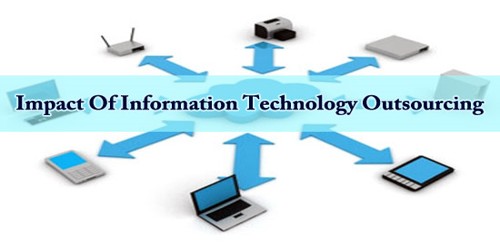Information Technology Outsourcing (ITO) is a phrase used to describe the practice of seeking resources or subcontracting outside of an organizational structure for all or part of an IT (Information Technology) function. It will continue to have a major impact on all organizations and will over time increasingly becomes an integral part of the organization’s strategy. Various aspects within the metamorphosis of ITO will be covered but not necessarily detailed.
ITO has become a global phenomenon. Globalization with some distinct drivers in technology evolution has reshaped the market place and given rise to the advent of the digital age. A sustainable competitive business strategy will need to embrace this opportunity and will need to seek enablers to exploit it. IT, by virtue of the web and broadband communications in particular, allows an organization to fulfill this need. Further decrease in cost communication, increase in broadband capacity and web collaborations accelerate the process.
Outsourcing is a vital part of a company’s evolving service delivery model and it is increasingly being used to capture market innovations, like robotics, and cognitive technologies, to enhance a company’s capabilities. Companies must be capable of adapting their sourcing cycle to capture value being created in the marketplace. By creating an innovation framework, and using that framework to select, contract, and govern vendor relationships, companies can capture new value, and build an innovation advantage.
“Outsourcing occurs when third-party vendors are responsible for managing the Information Technology components on behalf of their clients. IT Outsourcing means handing over the management of some or all of an organization’s information technology (IT), systems (IS), and related services to a third party.” (Willcocks et al.,1998)
Organizations adopt ITO for various reasons (Turban et al, 2006). The ever dynamic evolution within the IT sector grants great opportunity to business. The following reasons were invariably most common as per numerous surveys done and researched globally:
Cost reduction –
This has been the foremost reason to outsource as senior executives’ only views the IT function as a non-core activity and a necessary cost to be minimized. Economic pressures are also external factors that lead to the advent of ITO. Lacity and Willcocks(2001) explain that cost savings are no longer a major reason for outsourcing.
- Focus on core competency – Business deems IT as a cost center and excludes it from its core strategy. With increased shareholder demands organizations feel they need to refocus on broader business issues other than technology. Organizations place more focus on their “core competency” business (Field, 1999).
- Access to specialist expertise and technology – Highly skilled labor comes at a cost and also the technology and is also not readily available. ITO is not only for cost savings but as a tool for utilizing state of the art expertise and technology through their service providers (Field, 1999).
However, of late, the companies with strong IT capabilities, such as IBM, Microsoft, and SUN, are also outsourcing some of their IT functions to concentrate on their core-responsibilities and reduce costs to the economies of scale.
Decision Making –
In the past, organizations used frameworks and models as guidelines for assessing their current state and determining future strategic actions (Gorry and Scott-Morton 1971, Nolan 1973, Luftman 1999, Venkatraman and Henderson 1993). More organizations are considering ITO as part of their strategic thinking.
Organizations use ITO as a method to reduce costs, achieve efficiency and flexibility but many don’t realize the benefits due to bad decision making. ITO decision-making is a process and requires careful scrutiny before being finalized.
ITO decision-making process addresses a wide range of issues, such as economical (eg., financial feasibility), technological and political. This process starts with an in-house assessment of the IT capabilities which should highlight to management activities that can potentially be outsourced.
SWOT (Strengths, Weaknesses, Opportunity, Threats) analysis could be used to substantiate the need for whether ITO can possibly be used to negate those threats and weaknesses or whether at all necessary to explore ITO. The facts gathered should include a baseline and evaluation of the current environment which should be made available for executive management approval. Knowledge within the strategic decision at this higher level can thus be descriptive (know-what), procedural (know-how) or reasoning (know-why) (Fahey et al., 2001; Holsapple & Singh, 2000).
Case studies within surveys conducted by M.C.Lacity, L.P.Willcocks, and D.F.Feeny published in the Sloan Management Review(Spring 1996) summarizes the ITO process. The abovementioned reasons were most common in their samples.
Scope of sourcing –
Sourcing is often referred to in IT literature as outsourcing. The research delineates four categories of sourcing:
- Total outsourcing is where all IT activities including assets and management become the responsibility of a third-party vendor.
- Total insourcing refers to the in-house management of IT activities where the external or internal staff is used with the buying in of the vendor resources to meet a temporary need. Vendor resources are only used to supplement the internally managed teams.
- Selective sourcing locates selected IT activities to vendors while the customer remained responsible for delivering the result and will be held accountable.
- De facto insourcing uses internal IT departments to provide products and services that arise from historical precedent, rather than from a reasoned evaluation of the IT service market.
Considerations of sourcing –
A critical review of above categories found that the all-or-nothing approach (total outsourcing) characterized by long-term(5 years or more) deals can lead to trouble after a few years as exemplified in the case studies due to:
- Senior Management approach ITO like any other make-or-buy decision where ubiquitous IT applications across business functions complicate matters.
- Lost alignment between business and IT strategies.
- Failed promises to access new technologies.
- Processing power cost depreciates at an average of 20 percent annually due to the IT capabilities evolvement.
- And contractual costs soared greater than market prices.
- Termination of such contracts was found to be prohibitively expense.
- The research found that those who approach ITO in all-or-nothing terms either incur great risks or forego the potential benefits of selective sourcing.
Reasons for ITO can be categorized as two dimensional and based on:
- Purchasing style refers to contracts to either be once-off or an expectation of business for many years.
- Purchasing focus refers to companies buying resources from vendors, such as hardware, etc, and manages the delivery of IT themselves or vendors manage the IT activity and the organizations expect the specified results.
- A decision in selecting what can be outsourced usually distinguish between the contribution that IT makes to the business operations and it impacts on competitive advantage.
- ITO was primarily domestic but has now evolved due to globalization and can also be categorized now by the variance of service provider distance. The same reasons apply globally for ITO.
- On-shoring refers to the outsource vendor located in the same country of the customer.
- Near-shoring refers to the outsource vendor located geographically close but not in the same country.
- Off-shoring refers to the outsource vendor located offshore and possibly on a different continent and time-zone.
Managing ITO –
Once the scope and type has been identified, the vendor selection process will be initiated by soliciting via Request for Proposal(RFP). Not all service providers are equal as all offer different types of services like:
- IS consultancies/solutions providers – services in all IS functions
- Systems houses – system integration
- Hardware vendors – hardware platform
- Ex-IS departments – industry-specific sourcing
- Development houses – develop software
- Generic outsourcers – manage functions, especially infrastructure
Freelancers –
There are also important criteria to look for in your service provider.
Appropriate outsourcing experience and proven customer satisfaction track record.
Accredited in the application of best practices such as ITIL with the necessary evidence.
Adequate numbers of skilled labor.
Scale and geography to fulfill the organization’s needs.
Prepared to be flexible to your organization’s needs, i.e. plan with current staff.
Upon selection of the ITO partner, an outsourcing contract provides a legally bound, institutional framework in which each party’s rights, duties, and responsibilities are codified and the goals, policies, and strategies underlying the arrangement are specified. Selective sourcing allows for flexibility within the short contracts.
While some organizations realized their benefits in ITO, others have not been able to achieve benefits due to poor staffing of the IT function, poorly written service level agreements (SLA), lack of outsourcing experience on the client-side, poor project management skill, poor technical infrastructure (especially in some offshore cases), and lack of trust (Jennex and Adelakum 2003, Lacity and Willcocks 2001).
A contract alone is insufficient to guide outsourcing evolution and performance since it involves repeated inter-organizational exchanges that become socially embedded over time. This is why ICT outsourcing is very challenging and often a painful process!!
Governance is fundamental to outsourcing relationships. Tracking SLAs and ensuring compliance to contracts are critical to controlling costs and setting minimum performance requirements. It is therefore important to ensure that the ITIL framework, starting with support management, are implemented to ensure that the IT aligns with business with the necessary metrics in place.
Control Objectives for Information and Related Technology (COBIT) framework will ensure that all policies should be enforced, especially adherence to security.
Critical Success Factors in an outsourcing relationship that should mitigate risk:
- Define a strategy with measurable goals within your SLA to ensure the relationship doesn’t lose momentum over time.
- Exercise due diligence to establish a baseline for the relationship.
- With the adoption of the ITIL Framework, adopt a comprehensive change management strategy.
- Always keep senior management involved to ensure that adherence to policies and procedures.
- The right metrics and regular reporting build confidence and help sustain relations.
- As per the Tuckman’s stage model, the relationship should grow like a team and evolve in stages.
Stage one is the Insourcing stage where organizations buy only a few IT functions or services from external vendors on short term contractual agreements. Only a few IT activities are bought from outside parties, generally less than 5% of the entire IT operation.
Stage two is the Forming, or experimenting, stage. In this stage, organizations engage in sporadic outsourcing of IT activities. Sourcing activities may be between 10-20% of the entire IT needs in the organization.
Stage three is the Storming stage; it is regarded as a transition stage. At stage three organizations need to make a decision either to pursue outsourcing actively or to keep on experimenting.
Stage four is the Norming stage. At this stage, organizations have already made a decision to pursue IT outsourcing actively and have established some norms, methods or processes for IT outsourcing within the organization. The reason for outsourcing could be either cost focus or desire to improve internal efficiency. Outsourcing could account for up to 40% of IT activities.
The last stage is the strategic focus stage. In this stage, IT outsourcing is part of the corporate strategy and it is not based just on cost reduction or IT improvement but is a strategic decision to use IT outsourcing within the entire organization as part of a corporate strategy.
An organization would use IT outsourcing for functions ranging from infrastructure to software development, maintenance, and support. For example, an enterprise might outsource its IT management because it is cheaper to contract a third party to do so than it would be to build its own in-house IT management team. Or a company might outsource all of its data storage needs because it does not want to buy and maintain its own data storage devices. Most large organizations only outsource a portion of any given IT function.












